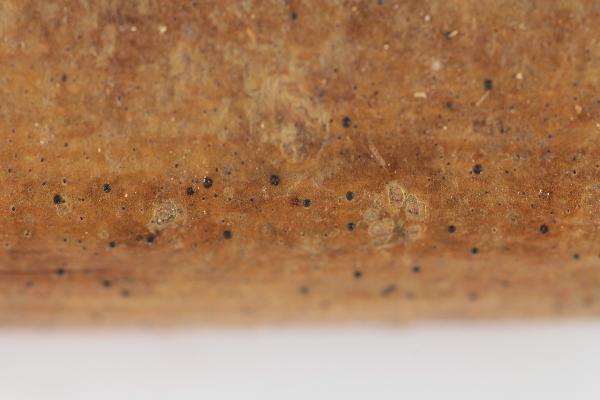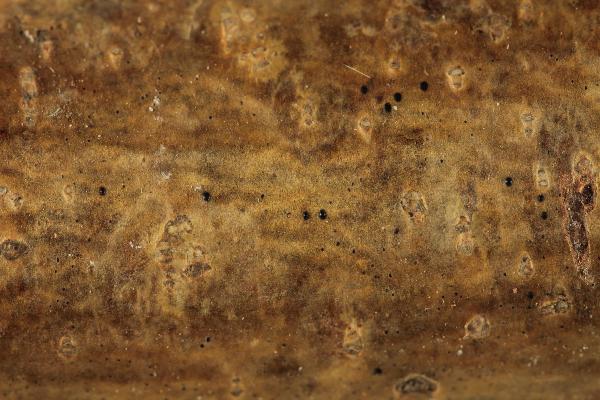Pyrenula coryli A. Massal.
Ric. Auton. Lich. Crost.: 164, 1852.
Synonyms: Arthopyrenia coryli (A. Massal.) Müll. Arg.; Mycopyrenula coryli (A. Massal.) Vain.; Verrucaria coryli (A. Massal.) Nyl.
Distribution: N - Ven (Lazzarin 2000b), TAA (Nascimbene & al. 2007b), Lomb, Piem (Isocrono & al. 2004). C - Laz, Abr (Ravera 2002b). S - Camp, Cal (Puntillo 1996).
Description: Thallus crustose, not lichenized, more or less immersed in the bark or inapparent, continuous, smooth, pale grey, without pseudocyphellae. Perithecia black, 0.2-0.3 mm across and c. 0.1-0.2 mm high, with a laterally extending, brown-black involucrellum. Exciple pale brown throughout, not continuous below the perithecial cavity; hamathecium of branched and anastomosed periphysoids, later substituted by more or less unbranched paraphyses; ostiole with periphyses; hymenium colourless, without anthraquinones, the hymenial gel K+ yellowish. Asci 8-spored, narrowly cylindrical, long-stalked, bitunicate, with tholus, thickened at apex with an internal apical beak, non-amyloid. Ascospores 3-septate, brown, thick-walled, narrowly ellipsoid, 10-17 x 4-6 μm. Pycnidia black. Conidia thread-like, c. 20 x 0.5 μm. Photobiont absent. Spot tests: thallus K-, C-, KC-, P-, UV-. Chemistry: unidentified substances in thallus. Note: a temperate, doubtfully lichenised species of smooth bark, most frequent on Corylus.
Growth form: Crustose
Substrata: bark
Photobiont: Trentepohlia
Reproductive strategy: mainly sexual
Commonnes-rarity: (info)
Alpine belt: absent
Subalpine belt: absent
Oromediterranean belt: absent
Montane belt: absent
Submediterranean belt: very rare
Padanian area: absent
Humid submediterranean belt: very rare
Humid mediterranean belt: absent
Dry mediterranean belt: absent

Predictive model
Herbarium samples


Felix Schumm - CC BY-SA 4.0
[Boom9793], Switzerland, Valais, Val d’Hérens S of Sion near Evlène, on Corylus. 1410 m. Leg. H. F. van Dobben & W. O. van der Knaap, 22.07.1990, det. A. Aptroot, 1990.
Thallus pale grey; pseudocyphellae mor or less absent; probably lichenized.
Ascomata 0.2–0.3 mm diam. and c. 0.1 mm high, with laterally
extending involucrellum; pigmented exciple not continuous below the
perithecial cavity; anthraquinones absent. Ascospores 10–17 × 4–6 μm,
3-septate. Pycnidia scattered amongst the perithecia; conidia 20 × 0.5
μm, thread-like.


Curtis Randall Björk - CC BY-SA 4.0
British Columbia, Fraser Plateau, near Prince George, Canada. On bark of Alnus incana in gully

Source: http://fungi.myspecies.info/file-colorboxed/11988; Owner: Uploaded by Mark Powell CC BY-NC 3.0

http://fungi.myspecies.info/file-colorboxed/11988; Owner: Uploaded by Mark Powell CC BY-NC 3.0
TSB 2370


Felix Schumm - CC BY-SA 4.0
[Boom9793], Switzerland, Valais, Val d’Hérens S of Sion near Evlène, on Corylus. 1410 m. Leg. H. F. van Dobben & W. O. van der Knaap, 22.07.1990, det. A. Aptroot, 1990.
Thallus pale grey; pseudocyphellae mor or less absent; probably lichenized.
Ascomata 0.2–0.3 mm diam. and c. 0.1 mm high, with laterally
extending involucrellum; pigmented exciple not continuous below the
perithecial cavity; anthraquinones absent. Ascospores 10–17 × 4–6 μm,
3-septate. Pycnidia scattered amongst the perithecia; conidia 20 × 0.5
μm, thread-like.


Felix Schumm - CC BY-SA 4.0
[Boom9793], Switzerland, Valais, Val d’Hérens S of Sion near Evlène, on Corylus. 1410 m. Leg. H. F. van Dobben & W. O. van der Knaap, 22.07.1990, det. A. Aptroot, 1990.
Thallus pale grey; pseudocyphellae mor or less absent; probably lichenized.
Ascomata 0.2–0.3 mm diam. and c. 0.1 mm high, with laterally
extending involucrellum; pigmented exciple not continuous below the
perithecial cavity; anthraquinones absent. Ascospores 10–17 × 4–6 μm,
3-septate. Pycnidia scattered amongst the perithecia; conidia 20 × 0.5
μm, thread-like.


Felix Schumm - CC BY-SA 4.0
[Boom9793], Switzerland, Valais, Val d’Hérens S of Sion near Evlène, on Corylus. 1410 m. Leg. H. F. van Dobben & W. O. van der Knaap, 22.07.1990, det. A. Aptroot, 1990.
Thallus pale grey; pseudocyphellae mor or less absent; probably lichenized.
Ascomata 0.2–0.3 mm diam. and c. 0.1 mm high, with laterally
extending involucrellum; pigmented exciple not continuous below the
perithecial cavity; anthraquinones absent. Ascospores 10–17 × 4–6 μm,
3-septate. Pycnidia scattered amongst the perithecia; conidia 20 × 0.5
μm, thread-like.


Felix Schumm - CC BY-SA 4.0
[Boom9793], Switzerland, Valais, Val d’Hérens S of Sion near Evlène, on Corylus. 1410 m. Leg. H. F. van Dobben & W. O. van der Knaap, 22.07.1990, det. A. Aptroot, 1990.
Thallus pale grey; pseudocyphellae mor or less absent; probably lichenized.
Ascomata 0.2–0.3 mm diam. and c. 0.1 mm high, with laterally
extending involucrellum; pigmented exciple not continuous below the
perithecial cavity; anthraquinones absent. Ascospores 10–17 × 4–6 μm,
3-septate. Pycnidia scattered amongst the perithecia; conidia 20 × 0.5
μm, thread-like.


Felix Schumm - CC BY-SA 4.0
[Boom9793], Switzerland, Valais, Val d’Hérens S of Sion near Evlène, on Corylus. 1410 m. Leg. H. F. van Dobben & W. O. van der Knaap, 22.07.1990, det. A. Aptroot, 1990.
Thallus pale grey; pseudocyphellae mor or less absent; probably lichenized.
Ascomata 0.2–0.3 mm diam. and c. 0.1 mm high, with laterally
extending involucrellum; pigmented exciple not continuous below the
perithecial cavity; anthraquinones absent. Ascospores 10–17 × 4–6 μm,
3-septate. Pycnidia scattered amongst the perithecia; conidia 20 × 0.5
μm, thread-like.


Felix Schumm - CC BY-SA 4.0
[Boom9793], Switzerland, Valais, Val d’Hérens S of Sion near Evlène, on Corylus. 1410 m. Leg. H. F. van Dobben & W. O. van der Knaap, 22.07.1990, det. A. Aptroot, 1990.
Thallus pale grey; pseudocyphellae mor or less absent; probably lichenized.
Ascomata 0.2–0.3 mm diam. and c. 0.1 mm high, with laterally
extending involucrellum; pigmented exciple not continuous below the
perithecial cavity; anthraquinones absent. Ascospores 10–17 × 4–6 μm,
3-septate. Pycnidia scattered amongst the perithecia; conidia 20 × 0.5
μm, thread-like.


Felix Schumm - CC BY-SA 4.0
[Boom9793], Switzerland, Valais, Val d’Hérens S of Sion near Evlène, on Corylus. 1410 m. Leg. H. F. van Dobben & W. O. van der Knaap, 22.07.1990, det. A. Aptroot, 1990.
Thallus pale grey; pseudocyphellae mor or less absent; probably lichenized.
Ascomata 0.2–0.3 mm diam. and c. 0.1 mm high, with laterally
extending involucrellum; pigmented exciple not continuous below the
perithecial cavity; anthraquinones absent. Ascospores 10–17 × 4–6 μm,
3-septate. Pycnidia scattered amongst the perithecia; conidia 20 × 0.5
μm, thread-like.


Felix Schumm - CC BY-SA 4.0
[Boom9793], Switzerland, Valais, Val d’Hérens S of Sion near Evlène, on Corylus. 1410 m. Leg. H. F. van Dobben & W. O. van der Knaap, 22.07.1990, det. A. Aptroot, 1990.
Thallus pale grey; pseudocyphellae mor or less absent; probably lichenized.
Ascomata 0.2–0.3 mm diam. and c. 0.1 mm high, with laterally
extending involucrellum; pigmented exciple not continuous below the
perithecial cavity; anthraquinones absent. Ascospores 10–17 × 4–6 μm,
3-septate. Pycnidia scattered amongst the perithecia; conidia 20 × 0.5
μm, thread-like.

Collezione lichenologica Abramo Massalongo del Museo di Storia Naturale G. Ligabue di Venezia - Autori: Seggi, Linda; Trabucco, Raffaella Proprietà: Fondazione Musei Civici di Venezia - CC BY-NC
Italy, Veneto, in op. Tregnago
Growth form: Crustose
Substrata: bark
Photobiont: Trentepohlia
Reproductive strategy: mainly sexual
Commonnes-rarity: (info)
Alpine belt: absent
Subalpine belt: absent
Oromediterranean belt: absent
Montane belt: absent
Submediterranean belt: very rare
Padanian area: absent
Humid submediterranean belt: very rare
Humid mediterranean belt: absent
Dry mediterranean belt: absent

Predictive model
| Herbarium samples |


Felix Schumm - CC BY-SA 4.0
[Boom9793], Switzerland, Valais, Val d’Hérens S of Sion near Evlène, on Corylus. 1410 m. Leg. H. F. van Dobben & W. O. van der Knaap, 22.07.1990, det. A. Aptroot, 1990.
Thallus pale grey; pseudocyphellae mor or less absent; probably lichenized.
Ascomata 0.2–0.3 mm diam. and c. 0.1 mm high, with laterally
extending involucrellum; pigmented exciple not continuous below the
perithecial cavity; anthraquinones absent. Ascospores 10–17 × 4–6 μm,
3-septate. Pycnidia scattered amongst the perithecia; conidia 20 × 0.5
μm, thread-like.


Curtis Randall Björk - CC BY-SA 4.0
British Columbia, Fraser Plateau, near Prince George, Canada. On bark of Alnus incana in gully

Source: http://fungi.myspecies.info/file-colorboxed/11988; Owner: Uploaded by Mark Powell CC BY-NC 3.0

http://fungi.myspecies.info/file-colorboxed/11988; Owner: Uploaded by Mark Powell CC BY-NC 3.0
TSB 2370


Felix Schumm - CC BY-SA 4.0
[Boom9793], Switzerland, Valais, Val d’Hérens S of Sion near Evlène, on Corylus. 1410 m. Leg. H. F. van Dobben & W. O. van der Knaap, 22.07.1990, det. A. Aptroot, 1990.
Thallus pale grey; pseudocyphellae mor or less absent; probably lichenized.
Ascomata 0.2–0.3 mm diam. and c. 0.1 mm high, with laterally
extending involucrellum; pigmented exciple not continuous below the
perithecial cavity; anthraquinones absent. Ascospores 10–17 × 4–6 μm,
3-septate. Pycnidia scattered amongst the perithecia; conidia 20 × 0.5
μm, thread-like.


Felix Schumm - CC BY-SA 4.0
[Boom9793], Switzerland, Valais, Val d’Hérens S of Sion near Evlène, on Corylus. 1410 m. Leg. H. F. van Dobben & W. O. van der Knaap, 22.07.1990, det. A. Aptroot, 1990.
Thallus pale grey; pseudocyphellae mor or less absent; probably lichenized.
Ascomata 0.2–0.3 mm diam. and c. 0.1 mm high, with laterally
extending involucrellum; pigmented exciple not continuous below the
perithecial cavity; anthraquinones absent. Ascospores 10–17 × 4–6 μm,
3-septate. Pycnidia scattered amongst the perithecia; conidia 20 × 0.5
μm, thread-like.


Felix Schumm - CC BY-SA 4.0
[Boom9793], Switzerland, Valais, Val d’Hérens S of Sion near Evlène, on Corylus. 1410 m. Leg. H. F. van Dobben & W. O. van der Knaap, 22.07.1990, det. A. Aptroot, 1990.
Thallus pale grey; pseudocyphellae mor or less absent; probably lichenized.
Ascomata 0.2–0.3 mm diam. and c. 0.1 mm high, with laterally
extending involucrellum; pigmented exciple not continuous below the
perithecial cavity; anthraquinones absent. Ascospores 10–17 × 4–6 μm,
3-septate. Pycnidia scattered amongst the perithecia; conidia 20 × 0.5
μm, thread-like.


Felix Schumm - CC BY-SA 4.0
[Boom9793], Switzerland, Valais, Val d’Hérens S of Sion near Evlène, on Corylus. 1410 m. Leg. H. F. van Dobben & W. O. van der Knaap, 22.07.1990, det. A. Aptroot, 1990.
Thallus pale grey; pseudocyphellae mor or less absent; probably lichenized.
Ascomata 0.2–0.3 mm diam. and c. 0.1 mm high, with laterally
extending involucrellum; pigmented exciple not continuous below the
perithecial cavity; anthraquinones absent. Ascospores 10–17 × 4–6 μm,
3-septate. Pycnidia scattered amongst the perithecia; conidia 20 × 0.5
μm, thread-like.


Felix Schumm - CC BY-SA 4.0
[Boom9793], Switzerland, Valais, Val d’Hérens S of Sion near Evlène, on Corylus. 1410 m. Leg. H. F. van Dobben & W. O. van der Knaap, 22.07.1990, det. A. Aptroot, 1990.
Thallus pale grey; pseudocyphellae mor or less absent; probably lichenized.
Ascomata 0.2–0.3 mm diam. and c. 0.1 mm high, with laterally
extending involucrellum; pigmented exciple not continuous below the
perithecial cavity; anthraquinones absent. Ascospores 10–17 × 4–6 μm,
3-septate. Pycnidia scattered amongst the perithecia; conidia 20 × 0.5
μm, thread-like.


Felix Schumm - CC BY-SA 4.0
[Boom9793], Switzerland, Valais, Val d’Hérens S of Sion near Evlène, on Corylus. 1410 m. Leg. H. F. van Dobben & W. O. van der Knaap, 22.07.1990, det. A. Aptroot, 1990.
Thallus pale grey; pseudocyphellae mor or less absent; probably lichenized.
Ascomata 0.2–0.3 mm diam. and c. 0.1 mm high, with laterally
extending involucrellum; pigmented exciple not continuous below the
perithecial cavity; anthraquinones absent. Ascospores 10–17 × 4–6 μm,
3-septate. Pycnidia scattered amongst the perithecia; conidia 20 × 0.5
μm, thread-like.


Felix Schumm - CC BY-SA 4.0
[Boom9793], Switzerland, Valais, Val d’Hérens S of Sion near Evlène, on Corylus. 1410 m. Leg. H. F. van Dobben & W. O. van der Knaap, 22.07.1990, det. A. Aptroot, 1990.
Thallus pale grey; pseudocyphellae mor or less absent; probably lichenized.
Ascomata 0.2–0.3 mm diam. and c. 0.1 mm high, with laterally
extending involucrellum; pigmented exciple not continuous below the
perithecial cavity; anthraquinones absent. Ascospores 10–17 × 4–6 μm,
3-septate. Pycnidia scattered amongst the perithecia; conidia 20 × 0.5
μm, thread-like.


Felix Schumm - CC BY-SA 4.0
[Boom9793], Switzerland, Valais, Val d’Hérens S of Sion near Evlène, on Corylus. 1410 m. Leg. H. F. van Dobben & W. O. van der Knaap, 22.07.1990, det. A. Aptroot, 1990.
Thallus pale grey; pseudocyphellae mor or less absent; probably lichenized.
Ascomata 0.2–0.3 mm diam. and c. 0.1 mm high, with laterally
extending involucrellum; pigmented exciple not continuous below the
perithecial cavity; anthraquinones absent. Ascospores 10–17 × 4–6 μm,
3-septate. Pycnidia scattered amongst the perithecia; conidia 20 × 0.5
μm, thread-like.

 INDEX FUNGORUM
INDEX FUNGORUM
 GBIF
GBIF
 DOLICHENS
DOLICHENS



